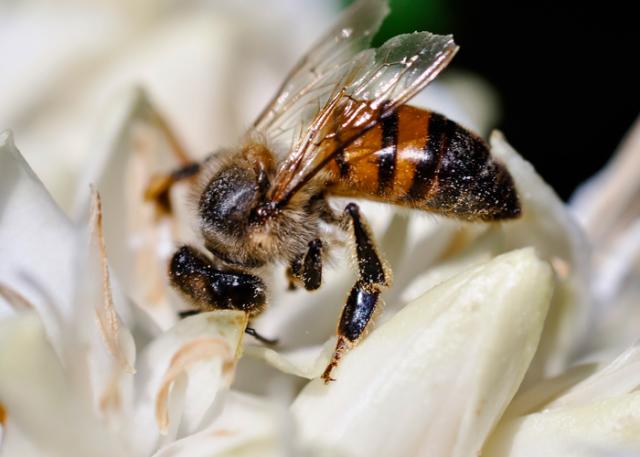Researchers assess bee mortality in Brazil
Researchers assess bee mortality in Brazil
Brazilian beekeepers have recorded bee losses in their beehives in recent years. Especially in the states of São Paulo and Santa Catarina, there have been cases of colony weakness, decline and collapse. Results from an analysis of the incidences have indicated that the mortality was not associated with pathogens (organisms that cause diseases) or parasites. Only two cases had characteristics that were similar to Colony Collapse Disorder (CCD), a problem that has caused concern in the United States and in European countries. Yet, in both such Brazilian cases, the causes could not be defined.
The information was compiled in the paper "Weakness and collapse of bee colonies in Brazil: are there cases of CCD?" , published in a thematic edition of the Brazilian Journal of Agricultural Research (Pesquisa Agropecuária Brasileira - PAB) in May 2016. The study gathered researchers from Embrapa Genetic Resources and Biotechnology, Embrapa Mid-North, the São Paulo State University (Universidade Estadual Paulista - Unesp), the Federal University of São Carlos (Universidade Federal de São Carlos - UFSCar), the United States Department of Agriculture (USDA), and the São Paulo Agribusiness Technology Agency (Agência Paulista de Tecnologia dos Agronegócios - APTA). The aim was to compile some of the most relevant studies related to the possible causes of losses and weakness in colonies of European bees (Apis mellifera) and of native bee species in Brazil.
The whole world has recorded the increasing disappearance of bee colonies, especially of European bees, the species more often used for the pollination of cultivated plants, as it easily adapts to different ecosystems and different types of management, and is a generalist in their search for resources. With other insects and animals, bees are directly responsible for increasing agricultural productivity, since about 70% of the plants used for human consumption depend on pollination.
According to the Embrapa Genetic Resources and Biotechnology researcher Carmen Pires, who specializes in pest ecology and is the article's first author, the disappearance of bees in the world is the result of different problems, including the use of agrochemicals; the loss of habitats due to diverse land uses; pathogens and parasites that attack the colonies, and climate change.
In Brazil, as Carmen explains, the situation is not different and colony loss points to the same problems faced in countries in Europe and the USA, places where CCD has been proven. To revert this situation, the article urges the establishment of programs to systematically survey bee health associated with assessments of the impacts of habitat fragmentation, of agricultural practices, and especially of agrochemicals, on bee communities.
Research developed in Europe and USA has generated a considerable volume of information on biotic threats (ecological relations inside an ecosystem) and abiotic threats (environmental factors that influence living beings) to bee health. Important scientific advances obtained mainly from molecular tools indicate that it is impossible to associate the collapse to a single factor.
Economic impacts in Brazil
According to data congregated in the PAB article out of the 141 plant species that are cultivated in Brazil for food, feed, biodiesel, and fibers, approximately 60%, that is, 85 species, depend on animal pollination. It is estimated that the economic value of the pollination performed by insects, especially bees, corresponds to 9.5% of the world's agricultural production. Moreover, honey production in Brazil generates over 300 million reais a year. From such data, it is possible to estimate the damage a collapse in bee populations could cause to the country.
CCD symptoms include the quick loss of worker bees, evidenced by the weakness or death of the colony with excess brood in comparison with the number of adult bees; absence of brood; and dead adult bees inside and outside the beehives. Another characteristic of the disorder is the inexistence of traces of pests, such as moths, for instance, which would indicate an immediate beehive invasion.
In Brazil, there is no system to monitor colonies in the apiaries and in their natural environment. The authors point to the pressing need for studies that broaden and deepen analyses of the possible causes of bee deaths at all their stages of development.
Bee deaths were observed in areas next to croplands where agrochemicals had been applied, but also in extremely remote places. According to the authors of this review, this fact can indicate that on top of the direct effect of chemical products on the insects, there may be an interaction with pathogens in nature.
In Brazil, there are about 1,700 bee species, among which many can work as pollinators in 89% of the native flora. According to the authors, one of the solutions to attenuate the problem is to widen observation of native bee susceptibility to the different products used in Brazilian agriculture today.
There is only one specialized laboratory in Brazil, located in the São Paulo Agribusiness Technology Agency (APTA) , which cannot meet the national demand. The ideal would be at least a laboratory per region.
On top of such issues, there is the high cost of laboratorial analyses of residue, and the fact that beekeeping in most cases is not the farmer's main activity.
One of the solutions suggested by the study is the establishment of a network of laboratories to support epidemiological surveys. The researchers recommend the establishment of an effective colony monitoring system in apiaries and natural environments. In Brazil there is no comprehensive organized registry of beekeepers and stingless beekeepers. There are some isolated initiatives by agricultural defense professionals and farmers, but there is no uniformization, which makes intercommunication impracticable. "Without effective knowledge of bee keepers and colonies in Brazil, it is not possible to measure the magnitude of the losses or to safely associate them to CCD or other collapses", Carmen ponders.
Therefore, the main recommendation from the scientists is to hold broader assessments of bee health in the domestic territory, considering the effect of the active principles that compose agrochemicals in field and semi-field conditions and especially in the long run. Researchers suggest the establishment of a national fund run by the private initiative and managed by public research agencies as viable solution to finance such further studies.
Currently, the results obtained are the fruit of laboratory tests, which represent knowledge advances and can inform governmental decisions, but need to count on complementary assessments performed in field and semi-field conditions.
Although it did not confirm the occurrence of CCD in Brazil, the study clearly states that the risk is imminent because many of the factors associated with the collapse are found in the country today. For the authors, the situation in Brazil is worrisome enough. About a third of the domestic territory has already been modified, which has led to the loss of large areas of natural vegetation. In addition, possible impacts of habitat fragmentation on bee communities have not been duly assessed yet.
Read the full article on PAB.
Translation: Mariana de Lima Medeiros
Fernanda Diniz (MTb 4685/89/DF)
Embrapa Genetic Resources and Biotechnology
Press inquiries
recursos-geneticos-e-biotecnologia.imprensa@embrapa.br
Phone number: (61) 3448-4768
Further information on the topic
Citizen Attention Service (SAC)
www.embrapa.br/contact-us/sac/


